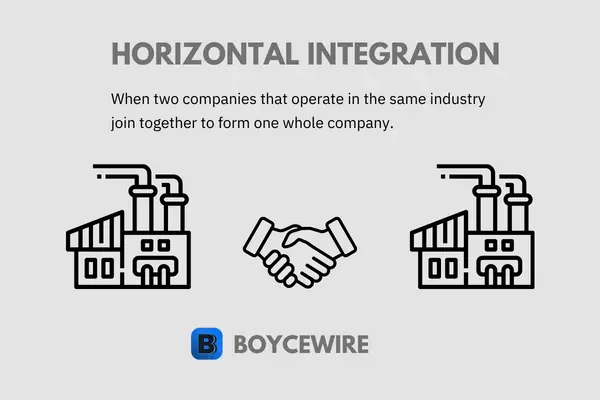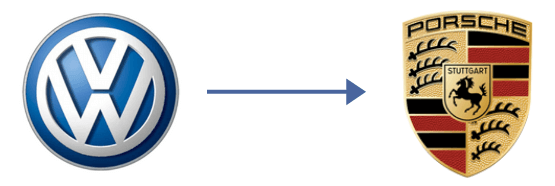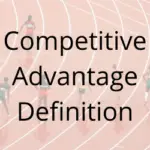Horizontal Integration: Definition, Examples, Pros & Cons

What is Horizontal Integration?
Horizontal integration is where a business joins with another at the same stage of the supply chain. In other words, two businesses that are similar, become one company. For instance, a merger between Nike and Adidas would be an example of horizontal integration. Both firms operate in the manufacturing and distribution of sportswear.
It is important to note that horizontal integration can also occur between industries – so long as they are at the same stage on the supply chain. For instance, an oil and gas extractor in Saudi Arabia may purchase a coffee bean growing firm in Brazil. Both companies are raw material extractors, so are at the same stage of the supply chain – yet are in different industries.
Key Points
- Horizontal integration is where two companies at the same stage of the supply change join together to form one company.
- Most forms of horizontal integration occur within the same industry, but can also occur in a completely different industry, but at the same stage of the supply chain.
- Horizontal integration is associated with cost synergies, but these don’t always pay off in management do not successfully integrate the two companies.
Although horizontal integration can take place between industries, it usually occurs between two competitors – generally because it creates greater efficiencies. In turn, this can potentially result in a monopoly if the two firms are large enough. For instance, Boeing and Airbus both manufacture airplanes – owning a combined 99 percent market share. If the two firms were to horizontally integrate, a monopoly would form.
Horizontal integration occurs when one company agrees to purchase the other – an acquisition. Alternatively, two companies may decide to form one company and agree to a merger. This is done with the aim of capturing a number of advantages – primarily increased efficiency and lower costs of production.
There may be industry-wide pressure on costs – perhaps inputs have increased in price. In turn, this can lead to competing firms looking to horizontally integrate in order to reduce the burden of higher costs and benefit from economies of scale. Alternatively, it may be to achieve greater purchasing power over suppliers – thereby reducing the cost of the inputs.
Horizontal Integration Examples

Disney and Pixar
In 2006, Disney purchased Pixar in a deal that was worth $7.4 billion. Both Disney and Pixar are in the business of making animated movies and shows – meaning the deal was a form of horizontal integration. Although Disney has a greater variety of product offerings, it’s main business is situated horizontally from that of Pixar.
The deal benefited both parties as Pixar had a state of the art and innovative design studio – whilst Disney had the big budgets and distribution networks.
Vodafone and Idea
In August 2018, Vodafone India and Idea Cellular merged to create the largest telecommunications firm in India – owning around 35 percent of the market. Both firms were selling telecommunication services such as mobile, phone, and internet providing’s – making it a clear example of horizontal integration.
The deal became one of necessity as a new entrant, Jio, took more and more market share away – eventually becoming the market leader in 2019. Jio became popular due to its cheap and competitive offerings. This squeezed profit margins in the industry and all but forced Vodafone and Idea to merge.
According to the deal, $2 billion in savings were meant to be made – although it is still too soon to tell whether the deal was a success.

Volkswagen and Porsche
The merger between Volkswagen and Porsche began in December 2009, where Volkswagen purchased a 49.9 percent stake in Porsche. The full merger was due to happen in 2011 – where Volkswagen would take full ownership. However, it was delayed due to a number of legal proceedings taking place.
The deal was completed shortly after in 2012 for around $5.6 billion for the remaining 50.1 percent stake.
Both firms operate within the industry of motor vehicle manufacturing – making the deal another example of horizontal integration.
Volkswagen benefits by adding a new company to its portfolio – diversifying away from family cars. At the same time, both companies benefit from increased network coverage and manufacturing synergies.
Facebook and Instagram
In 2012, Facebook purchased the photo-sharing app, Instagram, for $1 billion. At the time, it was an extortionate amount for a company with 13 employees. Yet both firms were operating in the social media industry – offering its consumers a way of socialising and communicating with each other.
The companies are direct competitors and Facebook saw that early on. If Instagram was going to take its consumers, then it was best that it acquired it early on. This was good business for Facebook, as Instagram is now valued in excess of $100 billion.
This was a good deal for Facebook. It acquired an up and coming competitor, whilst also diversifying its portfolio, risk, and income revenues.

Exxon and Mobil
We know ExxonMobil as one company today, but that entity originates from the 1998 merger between Exxon and Mobil – two separate companies in the oil and gas industry. At the time, the merger was said to be worth over $73 billion – making it the third most valuable company in the world.
This horizontal integration between the two oil giants was driven by falling oil prices and global competitive pressures. The merger helped the firm diversify its portfolio, with each company having a foothold in different parts of the world. For instance, Exxon had experience of deepwater exploration in Western Africa – whilst Mobil had facilities present in Nigeria and Equatorial Guinea.
Horizontal Integration Advantages
1. Economies of Scale
When two companies merge together, they can benefit from a number of efficiencies. First of all, it doesn’t need so many staff members – especially in departments that overlap. For instance, finance and HR might see a lot of redundancies as many of the tasks can be condensed and made more efficient.
The combined company can also benefit from the increased purchasing power of suppliers, as well as the knowledge and expertise of the company it is combining with. One company may have a more efficient process that it can share with the other, thereby reducing costs.
2. Market Power
As part of horizontal integration, two companies join together and create an even bigger one – the market share of each is combined. That means it has a greater ability to dictate prices in the market. A company that now has a 30 percent market share instead of 15 percent has a greater influence.
This influence covers both its power to dictate prices to consumers, but also to suppliers. Both have fewer options to buy or sell to, respectively. This allows the new firm to benefit from lower costs and potentially higher sale prices.
3. Product Differentiation
Horizontal integration generally occurs when two companies in the same industry combine (although infrequently occurs in unrelated industries, but at the same stage of the supply chain). We would, therefore, expect a significant level of product overlap. However, there is also some level of product differentiation.
If we look at Facebook and Instagram for example – both are social media entities, yet Instagram is very photo orientated, thereby attracting a different target market. Inevitably, a lot of the users overlap – although many will prefer one over the other. Consequently, this allows the combined company to capture a greater proportion of the market.
4. Reduced Competition
If we look at the purchase of Instagram by Facebook again – what we see is a reduction in competition. Instagram is one of Facebook’s biggest competitors in the social media sphere. Yet for the combined company, it doesn’t matter. If a consumer leaves Facebook to join Instagram, there is no net loss.
Facebook itself has far less competitive pressure since it acquired Instagram. That means it can protect against revenue losses and dictate prices to advertisers on its platforms.
5. Access to New Markets
As we saw with the merger of Exxon and Mobil – they both operated in different markets. Inevitably, each had expertise working in one country over another. As a result of the merger, they were able to share that working knowledge, thereby allowing it to penetrate the market further.
Local knowledge is almost priceless – so is an important advantage. Not only can it help the other firm to penetrate the market, but also allow it to introduce other products that it has to offer.
6. Lower Costs and Reduce Risk
When we look through examples of companies that have undergone horizontal integration, we find a lot of them were facing cost pressures. By combining, they are able to benefit from the economies of scale and the efficiencies it presents.
At the same time, horizontal integration can reduce risk. For instance, if the two companies are operating in different countries, it reduces the risk of both a decline in domestic demand, but also currency fluctuations. Both can cause quite substantial declines in company revenue. Yet by integrating with each other, this risk can be reduced.
Horizontal Integration Disadvantages
1. Diseconomies of Scale
Some companies envisage massive cost savings from horizontal integration. Yet these savings do not always come to fruition. When two big companies become one huge international one, the efficiencies are not so straight forward. They require sophisticated managerial planning and implementation. This doesn’t always come off.
Some companies will suffer from diseconomies of scale. This could range from duplicating work to financial over-spend to a decline in efficiency due to a lack of competition. Here are some other types of diseconomies of scale.
2. Inflexible
The bigger a company becomes, the tougher it becomes for it to change direction. A strategic change may involve twice as many bureaucratic layers and significant levels of red tape to overcome. When two firms merge, there is also likely to be an additional layer of management – as well as a potential geographical expansion.
The firm may then have a South America, European, Asia, and African division to contend with. So to implement a company-wide change requires significant levels of planning to implement through its various divisions. Not only does this become difficult to implement, but is also time-consuming. This is why we have seen many big companies fail through the years – think of Sears, Blockbuster, and Blackberry.
3. Decrease Shareholder Value
Most companies decide on horizontal integration because they feel they will achieve great synergies and cost savings. There is a huge level of optimism from both parties – including shareholders. Share prices tend to rise on the back of such deals – with millions and billions of cost savings forecast.
The problem occurs when the forecasts were too optimistic and the synergies don’t quite pan out as intended. The result is an underperformance compared to that which was expected. We then see share prices fall once the market comes to terms with the fact the efficiencies didn’t come to fruition.
4. Competitive Regulations
When two companies merge, they often create a large company with significant market power. This can come at the cost of stricter regulations as officials look to curb its market power. Usually, competition commissions will block any anti-competitive deals. Yet some are arranged on the basis of strict regulations and/or with parts of the company splitting off into independent units.
FAQs
Horizontal integration is the process of acquiring or merging with competitors in the same industry or market, with the goal of increasing market share and reducing competition.
Two of the biggest oil and gas companies – Exxon and Mobil – merged in 1998, in a deal worth over $75 billion. The resulting company, ExxonMobil, is now the third largest company in the world and revenues of over $280 billion.
Horizontal integration is not illegal, but the competition commission has the power to prevent deals from going through if it deems the deal would create a monopoly, or significant market power.
Horizontal integration is important as it allows many firms to benefit from the synergies that can be achieved. In industries that are facing cost pressures, some are forced into integrating with another firm in order to reduce costs and stay in business. Others join purely in order to maintain a strong market position against a competitor that is taking more and more market share.
Companies engage in horizontal integration to achieve economies of scale, increase market power, reduce competition, and improve profitability.
About Paul
Paul Boyce is an economics editor with over 10 years experience in the industry. Currently working as a consultant within the financial services sector, Paul is the CEO and chief editor of BoyceWire. He has written publications for FEE, the Mises Institute, and many others.

Further Reading
 The Importance of Free Trade - True free markets don’t exist anywhere in the world. This is because free markets and free trade go hand in…
The Importance of Free Trade - True free markets don’t exist anywhere in the world. This is because free markets and free trade go hand in…  Competitive Advantage: Definition, Types & Examples - A competitive advantage is where one business has an edge over anothers. In other words, it is what makes the…
Competitive Advantage: Definition, Types & Examples - A competitive advantage is where one business has an edge over anothers. In other words, it is what makes the…  Excise Tax: Definition, How it Works & Examples - An excise tax is a tax that is levied on specific products, usually in order to create a socially optimal…
Excise Tax: Definition, How it Works & Examples - An excise tax is a tax that is levied on specific products, usually in order to create a socially optimal… 